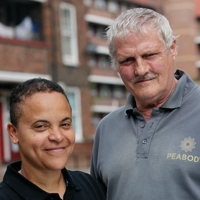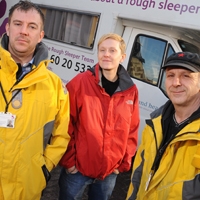On the front line
When riots ripped through England last week, most people watched the unfolding horror on their television screens. But for many housing professionals the sight of burning buildings, looted shops and mobs running amok was a shocking reality. Here, Alex Wellman relays their stories

The estate caretakers, Hackney, east London
As violence and looting erupted in east London on Monday last week, residents of Hackney’s Pembury estate had some familiar faces providing help and reassurance.
With more than 100 years’ combined service on the Peabody-owned estate, Pembury’s eight caretakers went out of their way to ensure residents were secure.
Tayo Waters, 49, who has worked as a Pembury caretaker for nine years, and Charlie Dilworth, 63, who has racked up 32 years, were told to go home by their concerned bosses at the 19,000-home association. They did - but only after warning others of the impending danger.
‘We were told to go home, but before we did we stopped and began telling tenants to get home and be safe,’ Ms Waters says. ‘We have certain gangs here and we knew if trouble broke out, they would definitely try to get involved and because of that we knew it could be bad.
‘After we heard something might be happening we saw an elderly tenant was walking down to [Hackney thoroughfare] Mare Street for a swift one [drink] and we warned him to go home and be safe.’
The caretakers were also involved in the clean-up operation in the immediate aftermath of the rioting. Although Pembury’s buildings were left unscathed by rioters, some stole bins from the estate and set them alight and the roads and pavements were littered with broken glass and burned metal.
‘Most of the debris was on my patch in south Pembury and we got down and got the place back to normal on the same day,’ Mr Dilworth says. ‘The grass was covered in bricks and bottles but we got great support from Hackney Council.
‘I just see my job as a cleaner and saying hello to everyone. I think you need to be able to support people and be nice to them as well as making the area clean for them.’

The homelessness outreach team, Birmingham
As the riots spread from London to Birmingham on Monday night, rioters in the second city subjected homeless people to horrifying attacks.
Housing association Midland Heart’s homelessness outreach team came across rough sleepers who had been punched and threatened. Its staff even found themselves in the midst of the violence.
‘We did not know it was going to go off. We had a van doing outreach [work] which was suddenly surrounded by youths. It sped off before anything could happen,’ recalls Steve Manton, team leader of the 32,000-home association’s rough sleeper outreach programme.
‘Next day [Tuesday], we went to hostels to make sure they all had a van so they could get away if anything happened. We spent the day engaging with rough sleepers, helping them move from the area or access other services. That may just have been [by providing] a bus ticket or it may have been more, but our priority was to make sure they were out of the area in case it happened again,’ he adds.
Mr Manton says Midland Heart’s team worked throughout Tuesday to support service users - but the homeless faced a second night of pain.
‘The next morning we went out again and found that one rough sleeper had his jaw broken, another had had a knife pulled on him, while a third had been dragged along and forced to go looting with a mob,’ he states. ‘Luckily he could not run fast so he managed to escape by slowing down. We helped them all access accommodation and hospitals.
‘It was a tough couple of days - two of the team saw a Tesco looted in front of them - but our priority was always ensuring we reached, and supported the rough sleepers.’

The council housing department, Haringey, north London
As news broke that rioting had started in Tottenham, north London, Mark Billings, team leader of housing options at Haringey Council, received a message on his pager. It indicated his team had a big job on its hands. It told him about the violence and that a number of homes had burned down.
Rioters badly damaged or destroyed 55 homes in the borough. Mr Billings’ team had to get to work straight away, putting in place a support network for the 55 households made homeless by the riots.
‘We have a very good emergency plan in place for things like this,’ he states. ‘We set up a sort of one-stop-shop for those who had lost their homes. We had people literally coming in smelling of smoke in their pyjamas, with no possessions. No money, no cards, no identification, nothing.
‘We have been able to do pretty much everything for these people. For example, we have sorted their council tax out [so they did not have to worry about paying it while in temporary accommodation] and other things like that.’
Mr Billings says his team was able to perform a ‘really quick’ turnaround for those who needed help to find accommodation.
‘We could have them in a hotel and in clean clothes within an hour of coming to us,’ he says with pride. ‘On top of all this we still provided our regular service.
‘Donations [of food, clothes and toiletries] have come flooding in and church groups have been helping out while the Haringey team has been working flat out since Sunday morning. It has only been three days but it feels like a week of hard work.’
The housing options team set up a special support centre in the housing department’s office but had to move it to a nearby leisure centre as there was more space for support.
The centre, which offers legal advice, victim support and financial advice for householders and businesses affected, was open from 9am to 8pm every day until today when it will be reviewed.

The first response team, Salford
Salford fell victim to rioting and looting on Tuesday evening and the city council’s arm’s-length management organisation - Salix Homes - soon found itself in the middle as hundred-strong mobs flooded the area.
Tony Riley, first response team leader for the 10,500-home ALMO, kept watch with others via Salix’s CCTV cameras, logging the rampaging youths. The team kept in direct contact with police to help them tackle the gangs, while ensuring the residents stayed safe.
‘Like everyone else, I was watching what was going on in London on the TV [on Monday],’ Mr Riley recalls. ‘I briefed my team the following morning that it might come to our area. We started getting groups of people gathering at around 2.30pm and then it all started about 3.30pm.
‘Riot police dispersed youths to Brydon Close [a small residential area close to the city centre]. From there, they began pelting police with bricks. Then when it got darker it all started to escalate.’
These were just 100 metres from Salix properties. Mr Riley says being able to keep watch via CCTV cameras was vital in preventing unauthorised access to Salix Homes’ properties.
‘We do not allow people into our blocks who are not supposed to get there and nobody got in during the riots,’ he says.
‘During the violence we worked directly with the police and kept track of what was going on when officers on the ground could not see.
‘It all stopped early the next morning and since then we have been working hard with the police to identify those who took part - a number of whom are our residents.’











